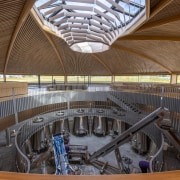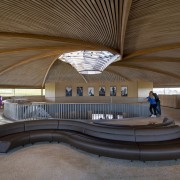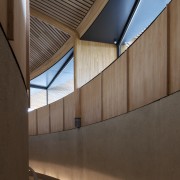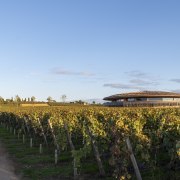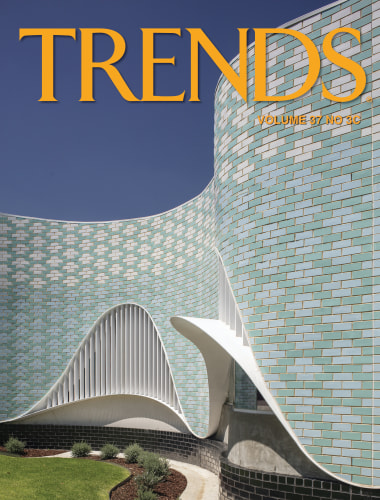Working with the land
Le Dôme Winery, by Foster + Partners, responds to its rustic setting with sympathetic form and credentials that are green as succulent grapes
Designed by Foster & Partners
From the architects:
Designed and engineered by Foster + Partners, Le Dôme Winery's low-lying building blends seamlessly with the UNESCO World Heritage Cultural Landscape of the Saint-Émilion region in Bordeaux.
The form of the building is rooted in a desire to create a structure that simultaneously looks both inwards and outwards, providing an efficient space for wine production, while engaging in dialogue with the surrounding landscape.
Norman Foster, founder and executive chairman, Foster + Partners, said: “When Jonathan Maltus The owner of Le Dome) first approached us, he expressed a desire to create a distinctive new winery, set against the unique backdrop of St Emilion.
“He wanted the building to be a celebration of the beautiful site, focussing on the views of the vineyard and making the landscape the primary protagonist in the design,” says Foster.
“The idea was to blend the building with its surroundings while creating a welcoming space for visitors and wine enthusiasts.”
Jonathan Maltus, owner: “When I first met Norman Foster in Madrid we spoke for over an hour and a half about what we required out of the project.
“Norman’s energy and personal interest shone when he, there and then, sketched the basic design of the building that has manifested itself so brilliantly in real life," Maltus says.
“What we see now, and it gives us so much pride, comes directly off the page that he drew in his notebook in front of me.”
Visitors approach the winery along a tree-lined avenue, at the end of which is a circular-plan building.
A combination of two ramps – one external, to emphasise the relationship with the site, and the other internal, allowing the visitor to walk through the different stages of the wine process – gives the new building its spatial definition.
Both ramps lead up to a gallery on the upper level which forms the social heart of the building with tasting tables, an elegant wine bar and entertainment spaces – all wrapped by 360-degree views of the adjoining vineyards.
The architectural and industrial design teams at Foster + Partners worked closely from the outset to create an interior design solution that is an integral part of the architecture.
To the left of the entrance, a curved wine bar looking out onto the vineyards accompanied by circular tables forms the tasting area to the left.
Straight ahead, the circular atrium allows people to look down onto the wine production and storage spaces below, providing a holistic and unique experience for visitors.
And to the right of the entrance, discrete office pods help create space for focussed work within a busy environment.
The timber screens wrap around the desk spaces to allow for acoustic and visual privacy while preserving sightlines to the outside and blending in with the architecture, with the lines in the ceiling reflected in the timber screens.
The 40m diameter timber roof is a unique reciprocal structure consisting of mutually supporting sloping beams that spans over large column-free space.
The structure naturally creates a 6m wide oculus at its centre, which allows daylight to flood the upper level.
The roof is clad with recycled local terracotta tiles, while the base of the building – made with concrete using aggregate from the region – is covered with timber slats and partially buried into the ground to reduce its visual impact on the terrain and increase thermal mass performance.
The building design reinforces the landscape by creating a hill-like form that echoes the gentle slopes that surround it.
Green as grapes
Structure/cladding- Laminated timber roof structure (laminated timber structure in a structural solution of reciprocal dome which provides carbon offsets and requires minimum energy consumption for erection on site); reclaimed roof tiles; glazed top section of the cladding; in-situ concrete drum at lower level
Energy and carbon
• Partially buried building benefitting from ground thermal mass to minimise energy consumption
• Limited number of environmentally controlled spaces – only where people will spend significant amount of time (i.e. visitor areas or offices)
• Central oculus provides adequate daylight throughout the year minimising the need for artificial lighting
Water
- Rainwater reservoir for irrigation and cleaning
Land and ecology
• Compact shape to minimise impact on UNESCO-listed vineyard landscape
• Vegetated canopy blends building within its site
• Key industry to promote agricultural production in the area
• Approach to site integration from both outside to inside and vice versa: top floor is fully glazed along the perimeter affording unrivalled 360 views over the surrounding vineyard
Wellbeing
Easy vertical communication via gentle ramps for both employees and visitors
Future proofThe building is designed with open-plan, column-free spaces which can accommodate future needs.
Credit list
Project
Foster + Partners architectural design team
Collaborating architect
Structural engineer
Acoustics
Architect
Foster + Partners industrial design team
Main contractor
Mechanical engineers
Joinery
Designed by: Foster & Partners
Story by: Trendsideas
Photography by: Photography – Nigel Young, Foster & Partners; drawing – Gregory Gibbon, Foster + Partners; plans – Foster + Partners
Home kitchen bathroom commercial design
9 tile shapes and finishes that think outside the square
Reflection and repose
Curves upon curves





